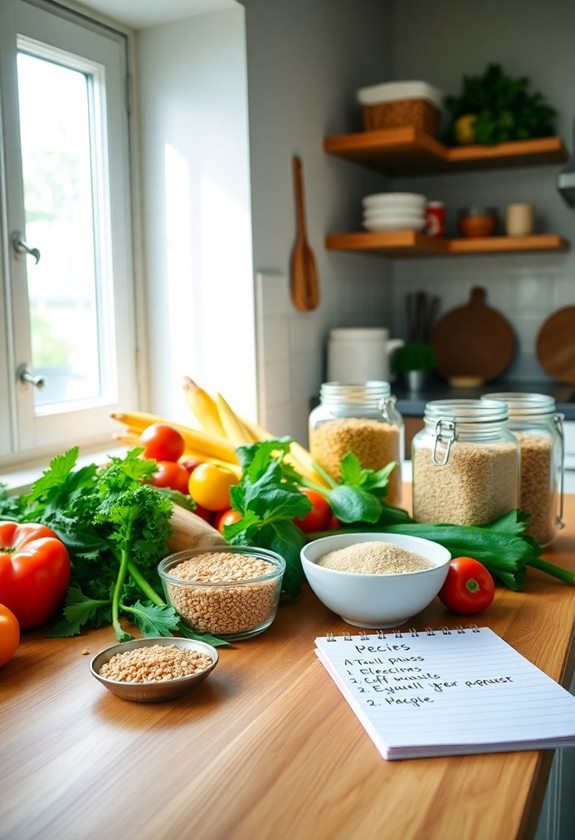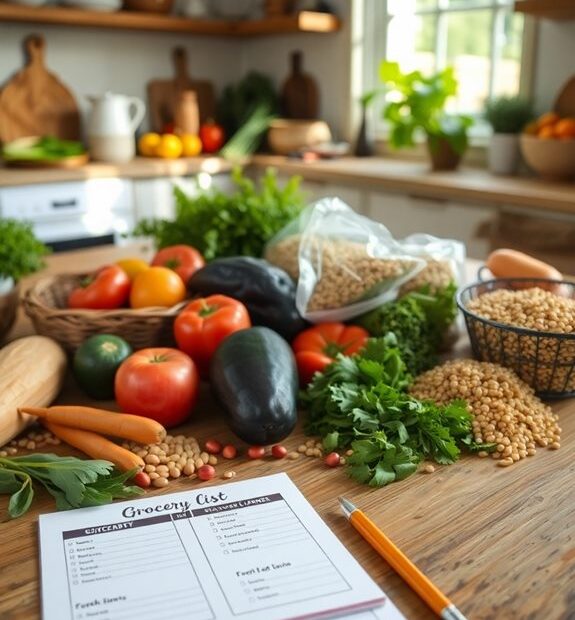Cost-effective meal planning is all about saving time and money while eating healthy. Start by jotting down weekly meal ideas. Have you checked your pantry lately? Using what you already have can cut down waste. Set a realistic budget—maybe $60 for groceries each week. It's smart to choose seasonal produce and bulk items to save even more! Don't forget to create balanced meals with all food groups. 🥦 How about prepping meals on the weekend? You'll feel so organized! If you stick with these tips, you'll master meal planning in no time and discover even more helpful strategies! 🌟
Key Takeaways
- Start by establishing a weekly budget and tracking your spending to control costs effectively.
- Create a meal plan using seasonal produce and similar ingredients to minimize waste and expenses.
- Utilize a shopping list to avoid impulse purchases and stick to your budget while shopping.
- Buy in bulk for staples like grains and beans to save money over time.
- Dedicate time for meal prepping to streamline cooking and ensure balanced meals throughout the week.
Understanding Meal Planning Basics

Meal planning basics are essential for anyone looking to save time and money in the kitchen. You might wonder, "Where do I even start?" Don't worry! It's easier than you think. First, think about your meals for the week. Jot down what you'd like to eat, and consider using color-coded portion control containers to help with meal variety and portion management. This helps you stay focused and avoid last-minute takeout.
Next, check your pantry and fridge. You'll want to use what you already have. Do you see any ingredients that need to be used soon? Planning meals around them can help reduce waste and save money.
Now, consider creating a shopping list. This list keeps you organized and prevents impulse buys. Have you ever walked into a store and left with things you didn't need? A list helps you avoid that!
Setting a Realistic Budget
When you begin planning your meals, setting a realistic budget is essential to guarantee you don't overspend. A budget helps you track your spending and make sure you can enjoy your meals without stress. Think about how much you can afford each week. It's okay to adjust as you go along.
Here's a simple way to break it down:
| Expense Type | Estimated Cost |
|---|---|
| Groceries | $60 |
| Snacks | $20 |
| Drinks | $15 |
| Meal Prep Supplies | $10 |
| Miscellaneous | $5 |
Isn't it helpful to see everything laid out? You can tweak these estimates based on your needs. For example, if you love snacks more than drinks, shift some funds around. Remember, sticking to your budget doesn't mean you can't enjoy good food! You can plan meals that use similar ingredients to save money. So, what will you prioritize in your budget? Take a moment to think about what works for you, and remember, every little bit helps! 😊
Choosing Affordable Ingredients

Choosing affordable ingredients can greatly stretch your budget while still allowing you to enjoy delicious meals. You don't have to sacrifice taste for savings! Start by shopping smart. Look for seasonal produce, which can be cheaper and fresher, and consider meal planning with resources like budget cooking guides that offer structured layouts and grocery lists. Buying in bulk gives you more for less, and it's perfect for grains and beans. Have you tried browsing local farmers' markets? They often offer great deals!
Here are a few tips to keep in mind:
- Plan Your Meals: Knowing what you need helps avoid impulse buys.
- Use Store Brands: They're often just as good as name brands but cheaper.
- Buy Frozen: Frozen fruits and veggies are just as nutritious and usually less expensive.
Creating Balanced Meal Plans
Creating Balanced Meal Plans
Crafting balanced meal plans is essential for maintaining both health and budget. When you think about your meals, do you consider all the food groups? A balanced meal should include fruits, vegetables, whole grains, lean proteins, and healthy fats. By mixing these, you'll not only feel full but also nourish your body. Utilizing tools like a Weekly Meal Planner can help streamline this process and keep you organized throughout the week.
Start by planning your meals for the week. Choose one or two proteins, like chicken or beans, and rotate them in different dishes. For example, you can use chicken in stir-fries, salads, or wraps. Don't forget to add a variety of colorful veggies; they're packed with vitamins! 🤩
It's also smart to include snacks. Nuts, yogurt, or fresh fruit work great and keep your energy up. Remember, balance isn't just about the ingredients; it's about portion sizes too. Are you eating enough, or are you overloading your plate?
Shopping Smartly for Savings

To maximize your savings while grocery shopping, it's important to plan ahead and stick to your list. Have you ever gone into a store without a plan and ended up buying things you didn't need? It's easy to be tempted by shiny packaging and sales. But with a little foresight, you can keep your budget in check!
Here are three smart shopping tips to help you save:
- Compare prices: Check different stores and online platforms for the best deals. You might be surprised at how much prices vary!
- Buy in bulk: If there's something you use often, buying in larger quantities can save you money in the long run. Just make sure it won't go to waste!
- Look for sales and coupons: Keep an eye on weekly ads or download apps that offer discounts. Every little bit adds up!
Tips for Meal Prepping Efficiently
Meal prepping can be a game changer for your weekly routine, saving you time and stress during busy days. But how do you make it work for you? Start by planning your meals ahead of time. Choose a few simple recipes you love, and write down the ingredients you need. This way, you won't get stuck on what to cook.
Next, set aside a couple of hours on the weekend. This is your time to chop, cook, and pack meals into containers. Don't worry about perfection—just focus on getting it done. You might even want to batch-cook grains or proteins to use throughout the week.
It's also smart to use versatile ingredients. For example, roasted veggies can go in salads, wraps, or as sides. And remember, leftovers can be your best friend! If you make extra, you've got lunch ready for the next day.
Frequently Asked Questions
How Can I Involve My Family in Meal Planning?
Involving your family in meal planning can be fun and stressful. Start by hosting a brainstorming session, letting everyone suggest their favorite meals. You'll create excitement, build teamwork, and discover new dishes together while saving money.
What Are Some Quick Meal Prep Ideas for Busy Weeks?
When you're short on time, try batch cooking grains, roasting veggies, or prepping proteins in advance. Use versatile ingredients to create quick meals. Don't forget to store leftovers for effortless lunches throughout the week!
Can I Meal Plan for Dietary Restrictions and Allergies?
Yes, you can absolutely meal plan for dietary restrictions and allergies. Start by identifying safe ingredients, then create balanced meals that cater to those needs. This way, you'll enjoy delicious, worry-free eating throughout the week.
How Do I Handle Food Waste While Meal Planning?
To handle food waste while meal planning, you should prioritize using ingredients that spoil quickly, repurpose leftovers creatively, and adjust portion sizes based on your needs. Also, store food properly to extend its freshness.
What Tools or Apps Can Help With Meal Planning?
Did you know meal planning can reduce your grocery bill by up to 30%? You can use apps like Mealime or Yummly to streamline recipes and shopping lists, making your planning efficient and enjoyable.

